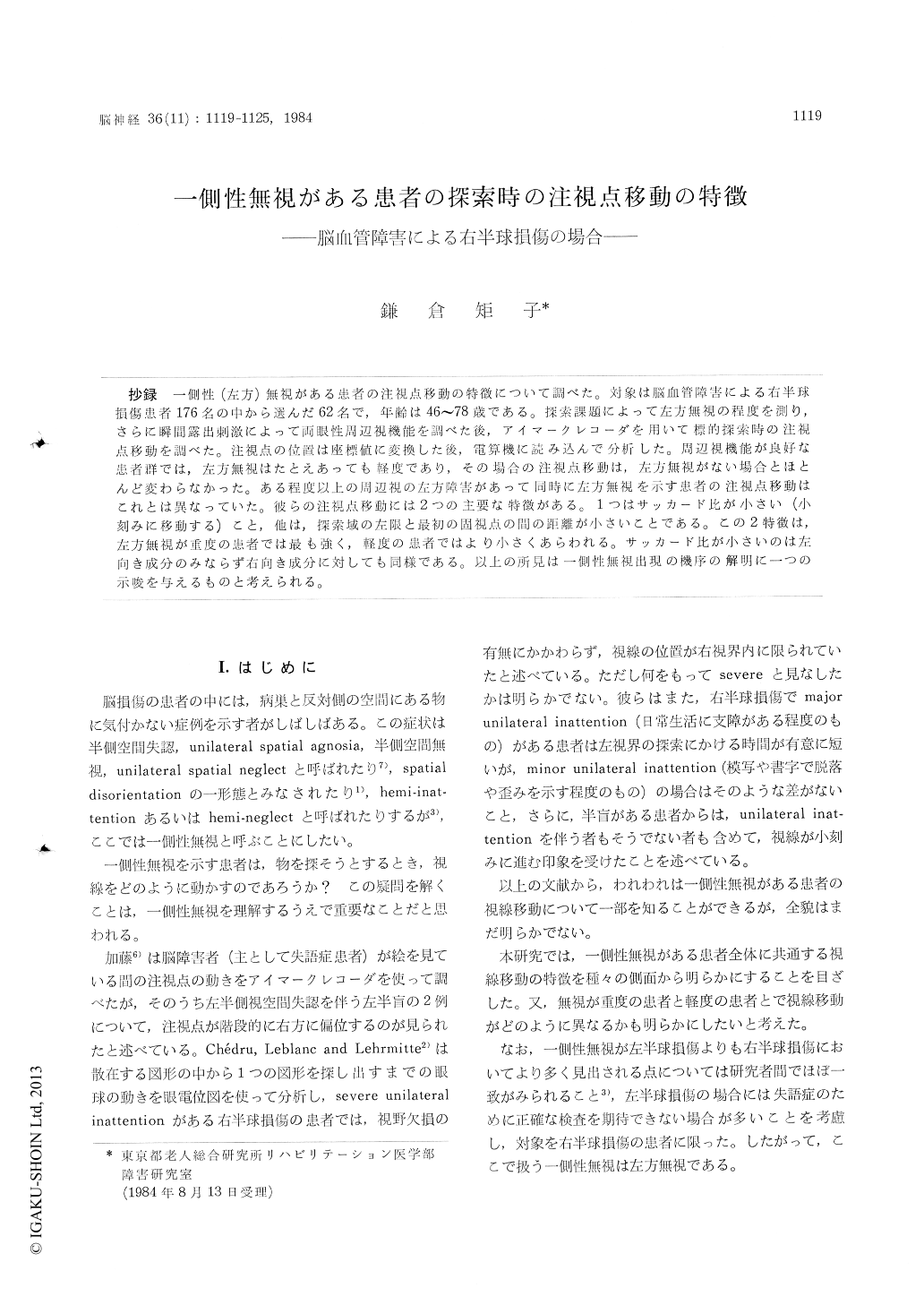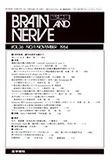Japanese
English
- 有料閲覧
- Abstract 文献概要
- 1ページ目 Look Inside
抄録 一側性(左方)無視がある患者の注視点移動の特徴について調べた。対象は脳血管障害による右半球損傷患者176名の中から選んだ62名で,年齢は46〜78歳である。探索課題によって左方無視の程度を測り,さらに瞬間露出刺激によって両眼性周辺視機能を調べた後,アイマークレコーダを用いて標的探索時の注視点移動を調べた。注視点の位置は座標値に変換した後,電算機に読み込んで分析した。周辺視機能が良好な患者群では,左方無視はたとえあっても軽度であり,その場合の注視点移動は,左方無視がない場合とほとんど変わらなかった。ある程度以上の周辺視の左方障害があって同時に左方無視を示す患者の注視点移動はこれとは異なっていた。彼らの注視点移動には2つの主要な特徴がある。1つはサッカード比が小さい(小刻みに移動する)こと,他は,探索域の左限と最初の固視点の間の距離が小さいことである。この2特徴は,左方無視が重度の患者では最も強く,軽度の患者ではより小さくあらわれる。サッカード比が小さいのは左向き成分のみならず右向き成分に対しても同様である。以上の所見は一側性無視出現の機序の解明に一つの示唆を与えるものと考えられる。
The characteristics of visual scanning in patients with unilateral visual neglect (UVN) were studied. Forty-one patients who showed UVN in the figure finding test and 21 patients who showed no UVN in the test were selected from 176 patients with the right-sided cerebro-vascular lesion. They ranged in age from 46 to 78 years. The severity of UVN in each subject was determined by the number of the figures neglected unilaterally in the figure finding test in which a subject was asked to circle the designated figures scattered among the other figures on the test paper. The following two tests were administered to each subject. Test 1 examined binocular peripheral vision by tachistoscopic method in which a white circle of 1°was presented for 1/8 sec at 15° from the central fixation point either unilaterally or bilaterally. Test 2 investigated the movement of gazing point while a subject was searching a target on a screen with his or her head stabilized. It was recorded on 16 mm movie Elm with Eye-Mark Recorder Model IV (Nac Co.) and converted into a series of position coordinates from which a visual scan path was reproduced and values cf variables representing characteristics of visual scanning were computed.
Six of 19 subjects who demonstrated "mild" UVN were found their peripheral vision intact. The characteristics of their visual scan path didnot differ from the ones of the other 9 subjects who demonstrated "no" UVN as well as intact peripheral vision. The visual scan paths of the subjects with UVN as well as defective left pe-ripheral vision were significantly different from the ones of those with the intact peripheral vision and no UVN. Two major characteristics were found in those patients. First, the relative frequen-cies of saccades were low both in left and in right direction. These frequencies are also low in upward and downward direction to the less extent in right and left direction. Secondly, the distance from the initial fixation point to the left limit of the search was short. These two characteristics were found in the greatest degree in thcse with "severe" UVN, whose scanning advanced by piecemeal within almost the right-side half of their initial visic n. The patients with the "mild" UVN demonstrated those characteristics in the less degree. The patients with the defective pe-ripheral vision and "no" UVN did net differ from the patients with the intact peripheral vision and "no" UVN in the distance frcm the initial fixa-tion point to the left limit of the search, but dif-fered in the relative frequencies of saccades.
The findings seem to indicate that; 1) the func-tional defect in left peripheral vision may affect the quality of UVN, and 2) the level of mental activity may determine the severity of UVN among those with defective left peripheral vision.

Copyright © 1984, Igaku-Shoin Ltd. All rights reserved.


